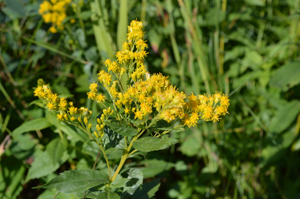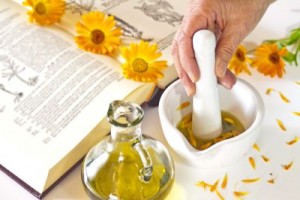
“ALTERNATIVE BAKING”
Alternative Baking by Marita Dreger
For all of you who need to avoid wheat, gluten and eggs. Check it out!
 The cookbook gives classic, contemporary and folk baking recipes that use alternative ingredients to wheat flour, cow’s milk, butter, chicken eggs and cane sugar. The way the book is set-up, you can customize the recipes to your own needs.
The cookbook gives classic, contemporary and folk baking recipes that use alternative ingredients to wheat flour, cow’s milk, butter, chicken eggs and cane sugar. The way the book is set-up, you can customize the recipes to your own needs.
Details specific to each type of flour and other ingredients are provided. Some of the recipes included are: crepes, pancakes, waffles, cookies, various cakes etc.
Hopefully the book is still in print.
Green blessings from the white north,
Gudrun
Mother Nature in Your Home
 The abundance and beauty of the Earth at this time of the year in the Peace Country is amazing. I encourage you to bring some of the magic of Mother Earth into your home by adding the wild greens to your food, preparing a cup of tea with fresh plants or harvesting and drying herbs for later use. Goldenrod is one of those amazing herbs you can see everywhere right now.
The abundance and beauty of the Earth at this time of the year in the Peace Country is amazing. I encourage you to bring some of the magic of Mother Earth into your home by adding the wild greens to your food, preparing a cup of tea with fresh plants or harvesting and drying herbs for later use. Goldenrod is one of those amazing herbs you can see everywhere right now.
Goldenrod is a fairly tall plant with beautiful, vibrant golden-yellow flowers. You will find it in dry woodlands, forest clearings and roadsides.
The Latin name Solidago originates from “solidus” & “ago,” Solidus, meaning “healthy and strong,” and ago meaning “to make whole.” Both of these terms refer to the plant’s ability to heal wounds.
Some common names for Goldenrod from various cultures also give an indication for its medicinal use as a wound healing herb, for example in Germany the herb is often called “Fastening Herb”. In fact in ancient German history Goldenrod was gathered as a wound herb before engaging in battle, just in case it was needed.
However, the focus today for its use has shifted from a wound healing aid, to a very reliable herb to support the kidneys. It promotes the elimination of urine and is applied for acute as well as chronic conditions of the kidneys and bladder including inflammation. In addition, it has been found to support the body during times of upper respiratory infections, especially when dealing with a chronic situation.
For medicinal purposes the leaves and flowers (early flowering stage) are being harvested and may be used fresh or dried. The fresh leaves and flowers can be used for wound healing or made into a tea, which can also be used as a wound wash. The dried herb may be used in the form of a tea as well but also as a tincture. A tincture is an alcoholic extract of a plant and is more concentrated than an herbal tea. The “crafty” person might want to try to use the flowers as a natural dye.
This summer Goldenrod has been brightening up the landscape in so many places and the quality of it has been superb. Many times you will find it being “infested” with many small bugs, but this year the only insects I have watched enjoying the bright, yellow flowers are butterflies and bees!
- If you are not sure how to prepare the herbs, remember that the DVD Herbal Pharmacy for Everyone provides clear and easy to follow instructions, teaching a great variety of herbal preparations. Check my website www.herbalinstructions.com for more information.
- Also remember the Herb Walk on August 20 if you would like to learn more about local plants and their medicinal properties.
Disclaimer
This information is not intended for the use of diagnosing any disease, condition or prescribing any treatment whatsoever. The use of any of the herbs and preparations is the sole responsibility of each individual and does not replace the services and advice of a medical practitioner and qualified healthcare provider. Consult a qualified healthcare professional before making medical decisions or if you have questions about your individual medical situation. No responsibility is assumed should the information be used in place of a licensed medical practitioner’s services.
CALENDULA OIL – PROPERTIES AND APPLICATIONS
 The oil is made from Calendula officinalis often referred to as Marigold. Many plants are called Marigold and therefore the Latin name is required for correct identification.
The oil is made from Calendula officinalis often referred to as Marigold. Many plants are called Marigold and therefore the Latin name is required for correct identification.
Why not plant some Calendula this year in your garden? The flowers are bright yellow and orange and have many therapeutic properties. It is easy to grow and harvest. The oil can be made into a healing salve which is a favorite of many of my clients.
PROPERTIES
anti-inflammatory – wound healing – anti-fungal – anti-bacterial/anti-microbial – anti-septic
Calendula oil is used topically and primarily used in SKIN CARE because of its great anti-inflammatory and wound healing actions.
APPLICATIONS
SKIN DRYNESS & IRRITATION
The oil helps to moisturize the skin, soothes the area and reduces pain.
Conditions: diaper rash, eczema, psoriasis, dermatitis, minor cuts and wounds, bed sores, insect bites, frost bites
FUNGAL INFECTIONS
Athlete’s foot, ring worm and jock itch
INFLAMMATION
Swelling from injuries i.e. sprained muscles and bruises, leg ulcers, spider and varicose veins.
HISTORICAL USE
Applied externally for abdominal cramps and constipation.
Buyer beware – Chemicals everywhere!
 The increased use of chemicals in our food and any product we use has reached unacceptable levels. The toxic load effects our body, mind, emotion and spirit in so many different ways plus we have individual reactions. Many times the specific culprit is difficult to pinpoint and frequently the cause is a combination of factors.
The increased use of chemicals in our food and any product we use has reached unacceptable levels. The toxic load effects our body, mind, emotion and spirit in so many different ways plus we have individual reactions. Many times the specific culprit is difficult to pinpoint and frequently the cause is a combination of factors.
Follow the link to an article about the additive methylisothiazolinone, a widely used preservative known to cause allergic reactions. Please share the information freely!
Growing Scrutiny For An Allergy Trigger Used In Personal Care Products
by Rachel Abrams
While some consumer products companies are removing the chemical, methylisothiazolinone, others are adding it to offerings including mouthwash.
Over 200 articles about the allergy problems with methylisothiazolinone, one of over 500,000 toxic chemicals thrown into everything. If it causes allergies it causes inflammation and irritation and maybe in 20 or 50 years it will be known as another carcinogenic. Read more »



Follow Us!